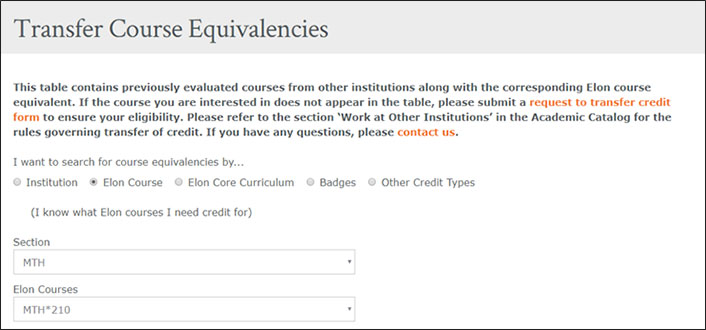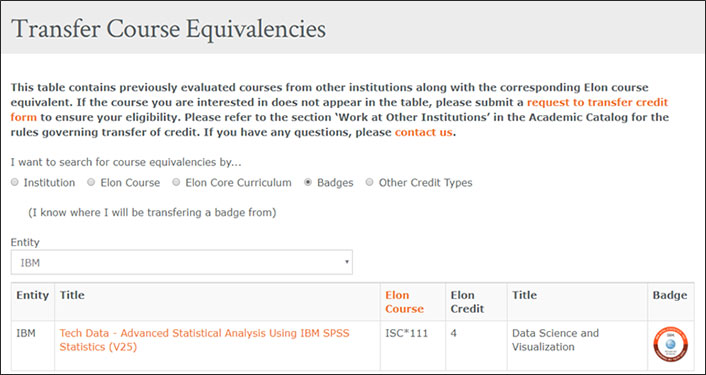Providing clear information about how credits—including from sources such as badges and other nontraditional credentials—will transfer to an institution can be enormously valuable for prospective students.

One of the most frequent questions that prospective students ask of registrar and admissions offices is how particular course credits will transfer to our institutions. As stackable credentials become mainstream, colleges and universities have started looking for ways to recruit more nontraditional students (that is, those who are 25 or older, are first-generation college students, or have dependents) and offer them academic credit in the hope that such students will matriculate and ultimately complete a degree. To accomplish this, many institutions have built robust transfer articulation tables that show how credits will transfer. For many institutions, it's one of the most widely used internet tools available, often allowing students to predict the number of credits they will earn if they transfer to the school.
Recognizing Students' Alternative Credentials
Transfer articulation is the key that unlocks the door for all learners to gain as much credit as possible toward a credential. This means not only accepting traditional academic credit from other accredited institutions but also recognizing the value of a variety of alternative records. These include certificates, badges, military experience, and global partnerships. Transfer equivalencies must be available and transparent to enable prospective students to make informed decisions about which pathway is right for them.
As articulation tables continue to evolve, some universities aim to introduce a more transparent process for transfer articulation and to establish clearer pathways toward earning a credential. Elon University is one of the institutions working to re-envision the process. The transfer articulation table at Elon University has an interesting design in that the data are both internal for enrolled students and outward-facing to help prospective students determine how their credits will transfer. The university's transfer data also include a robust number of international affiliates recorded through study-abroad opportunities. The goal moving forward is to expand our articulation table to reflect credit for emerging alternative credentials, such as badges and certificates. In recent years, we've begun to see colleges and universities award credit for badges. For example, Northeastern University has entered into a collaboration with IBM that enables students with the company's digital badges to apply them toward university credits.
As an early partner with Credential Engine—an organization that has created a cloud-based library that collects, maintains, and connects information on all types of credentials—Elon University has already modified it's Colleague Student Information System (a student success system) to be able to download badges and other forms of alternative credentials from the Credential Engine's library. The goal of the new table design is to evaluate badges and accurately describe them in the transfer articulation table so all students, enrolled or prospective, will know how their credentials could count toward a degree. The articulation of nonacademic credentials enables our team to recognize learners' knowledge gleaned from a variety of sources and experiences. As a result, Elon University will be able to collaborate with multiple industry and community partners teaching valuable skills that have yet to be integrated into the traditional classroom environment.
How Transfer Articulation Tables Work
Currently, students at our institution can search for equivalencies using a multitude of different criteria. They can sort through Elon's transfer articulation table by institution, Elon equivalency, or a specific Core Curriculum requirement, such as expression, civilization, society, science, advanced studies, world language, or first-year foundation (see figure 1).

By fall 2019, Elon will add badges and other credit types as a criterion within the articulation table, expanding the types of credit accepted. For example, for badging, our system will display the entity awarding the badge (e.g., IBM), the title of the badge, the course equivalent and corresponding title, and an image of the badge itself (see figure 2). A future enhancement would be to also hyperlink the badge to a badging source, if available.

Microcredentials offer learners a more flexible way to expand their knowledge and showcase new skills. Many of these credentials have substantive requirements, including evidence-based competencies and well-defined outcomes. As faculty approve new credit types, registrars can use existing technologies to highlight new opportunities for current and potential students. Each institution will need to decide on a process for evaluating and granting institutional credit, but once in place, articulation can expand exponentially. Future partnerships with alternative credential companies in this space such as Badgr, Credly, and other badging entities can further help institutions verify the microcredentials awarded and provide the information necessary to award requisite credit, opening up an exciting variety of pathways toward traditional degrees.
To view the design of Elon's current transfer credit table, please visit our Transfer Course Equivalencies homepage.
Rodney Parks is University Registrar, Assistant to the Provost, and Assistant Professor at Elon University.
© 2019 Rodney Parks. The text of this work is licensed under a Creative Commons BY 4.0 International License.
